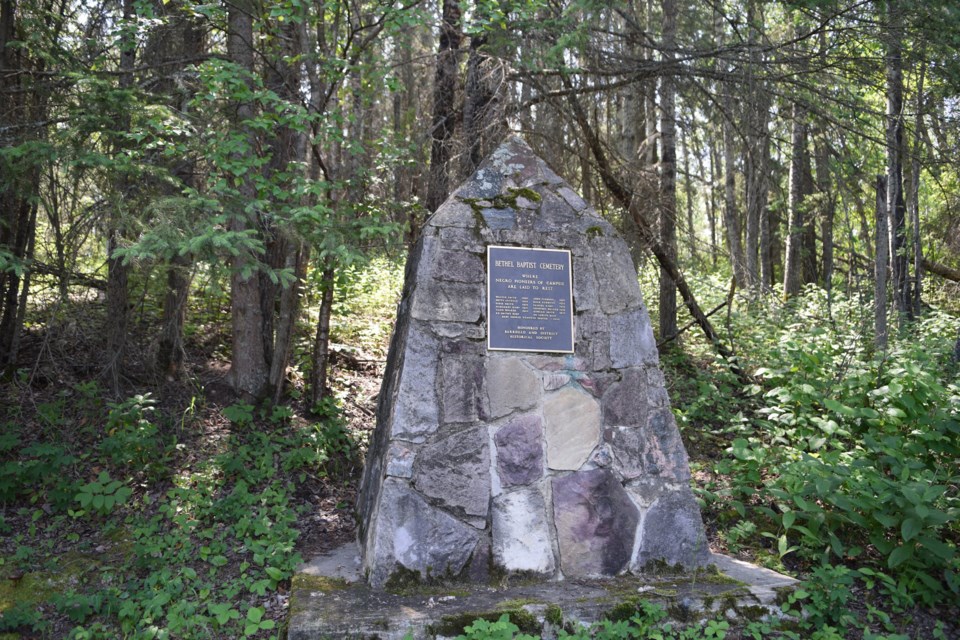BARRHEAD - It is a project that has been more than a year in the making.
This Friday, the Barrhead Church of Jesus Christ of Latter-day Saints, with the help of volunteers and Rose Garden Chapel, will install permanent stone grave markers underlaid by a concrete pad at the Bethel Baptist Cemetery for the 13 inhabitants of one of the first black settlements in Alberta.
Also on hand will be six to about a dozen relatives of those buried at the cemetery.
The church, with the help of Barrhead and District Family Support Services (FCSS), has been raising funds for the project starting in 2023 to replace the aluminium-etched grave markers the church markers installed in the early 2000s an unidentified baby someone in the cemetery.
The cemetery has 14 inhabitants, said Bill Warwaryick, one of the project's organizers said.
"The first two burials were in 1920; the last person [officially buried and recognized on the memorial] was in 1948," he said.
However, Warwaryick said another person was buried at the cemetery in the early 2000s, long after the province decommissioned it in 1950, adding the grave already has a marker, so they are concentrating on the original 13 gravesites.
The church's connection with the cemetery began in 1996 as part of the marking of the Church of Jesus Christ of Latter-day Saints' 150th anniversary, July 26, 1997; they asked their congregations to take on a day of service and perform works to help their community.
Warwaryick said the Barrhead church chose the clean-up of the Bethel Baptist Cemetery as its project because some of its members lived close to the historical site, and many of its members knew members or relatives of the original black settlement in Campsie.
"So we decided we were going to brush the cemetery and find the original grave markers," he said, adding it was not an easy job. "[The cemetery] had been basically abandoned from 1950, and the forest had grown in."
When they found the original grave markers, Warwaryick said they learned they had not weathered well, which he said shouldn't have been surprising.
"There were no permanent markers for any graves," he said. "All there was was temporary funeral home-style markers."
Since that time, Warwaryick said the congregation took it upon themselves to maintain the site.
He said the church installed a more permanent nameplate etched in aluminium mounted on cement sometime in the early 2000s, replacing the original markers.
Unfortunately, in August 2022, during one of the church's regular maintenance sessions, Warwaryick said volunteers noticed that the replacement nameplates were beginning to fade, in some cases to the point where they were nearly illegible.
He added that congregation members then discussed the possibility of once again replacing the grave markers with something that would weather better, leaning towards stone.
Warwaryick said then that in late 2022 and early 2023, Barrhead FCSS was looking for a project to take on as part of Black History Month to make the public aware of the contributions of the black settlers in the area.
"When they learned about our church's efforts, they asked if FCSS could partner with us," he said, adding they took over the fundraising efforts.
Specifically, the organization hosted a Paul and Christine Beaver presentation about their family's history in Campsie in the early 1900s. The presentation raised over half the approximately $8,000 needed for the project.
Warwaryick said the new markers would include more information, such as birthdates, maiden names of spouses, et cetera, about the 13 people buried at the cemetery, aided largely by the Beaver's research.
Currently, the church is roughly $2,000 short of the needed amount, but the Rose Garden Chapel will install the new grave markers, knowing the group will pay in full after they raise the final amount.
"They've been incredibly good to us and are excited to see the project completed," Warwayick said.
The settlement at what is now Campsie existed from about 1908 to the early 1940s.
According to census records, about 1,000 people came to Alberta from 1905 to 1911. The majority of these settlers chose to settle in Amber Valley (near Athabasca), Breton (near Drayton Valley), Junkins (near Wildwood) or Eldon and Rosetown in Saskatchewan. However, 36 homesteaders or about 30 families, settled in Campsie. At its height, the settlement had upwards of 70 settlers.
The cemetery is about 19 kilometres west of Barrhead on Highway 18 or 1.5 kilometres past the Highway 18 and Highway 763 intersection.
Barry Kerton, TownandCountryToday.com




